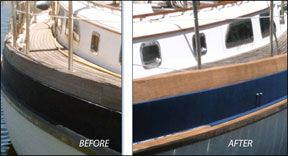I recently read your article on two-part teak cleaners (May 2010), and the timing was perfect as I was about to undertake that very job on my 43-foot Slocum. I needed to clean the toerail and the rubrail, which had never seen varnish. I used the West Marine Heavy-Duty product, which you recommended, and followed the instruction to the letter. It was very easy to work with, less caustic then other solutions, and did wonderful job.
Edward Haran
Chotto
Galveston Bay, Houston, Texas

Photos courtesy of Edward Haran
In regards to your article in the June 2010 issue on mildew preventers: In my experience, the fabric-softener dryer sheets branded as Bounce (www.bouncesheets.com) work as well or better than anything else and are far less expensive.
I recommend putting a sheet or two of Bounce in each locker, under each bunk cushion, and into any semi-enclosed space where ventilation is scan’ty. This not only prevents mildew, it leaves foul-weather gear smelling fresh and kinda perfumey. There are hundreds of sheets in each $5 box of Bounce, and a single box ought to provide enough protection for a full season or longer.
Capt. Bernie Weiss
www.AtlanticYachtDelivery.com
Like some of the products we tested for the June issue, Bounce, unfortunately, won’t help clean mildew stains. But, like you, we’ve found that it does minimize mildew, at least in clothes cabinets and other dry storage lockers. We’ve not yet tested it with vinyl cushions, and aren’t sure how to put it to work on things like life jackets, but it would be interesting to see how Bounce stands up over time to mildew preventers like Concrobium, which is a registered fungicide. Spray mildew preventers have more applications than dryer sheets, but for those lockers where using a spray isn’t practical (like clothes storage), Bounce is definitely worth the $5 effort.
I purchased my 1974 Island 20 about 20 years ago and inherited a persistent mildew problem in the cabin. Every spring, I put on a mask and spray down all the surfaces with Clorox Clean-up Cleaner with bleach (www.clorox.com). It keeps the mold at bay for the season, and because it has a detergent, it cleans as well. It is also useful for areas above decks, including cleaning moldy teak. The best thing is that it is readily available and can cost as little as $3 for 32 ounces.
Dale Deutsch, PhD
1974 Island 20
Stony Brook, N.Y.
Regarding onboard blenders like the one PS reviewed in the June 2010 Chandlery: A quarter-inch socket drive adapter in an 18-volt drill mates perfectly with the eight-point drive socket on an ordinary Oster blender (www.oster.com). Leave the heavy base ashore and put the cordless drill to double duty. If you want a tidier solution, the Boatblender (www.boatblender.com) is a $30 kit that does away with the lid, using the same quarter-inch drive.
Peter Tollini
Via e-mail
If you haven’t tested this, you should check it out: Right Stuff (Formula 3000) De-Ruster Metal Conditioner (www.sunbeltchemicals.com). I’ve been using it for a couple of years now, and I’m amazed by how good it works.
For example, I spray it on a corroded stainless-steel shackle, come back a day or two later, and the corrosion is gone, plus a protective coating that lasts months is left behind. It doesn’t work instantly and can’t be used on aluminum, but there’s no rubbing, scrubbing, or polishing. It just eats the rust and re-metals the surface. The problem is that you can’t find it in any stores! However, the company takes phone orders.
Tim Benner
I Dream of Jeanne
This appears to be an acid product similar to several we tested in April 2007. If so, rinse thoroughly and keep it off your gelcoat. We’re working on an update, so we’ll track this “miracle treatment” down. In the meantime, readers might also want to look at the electrolytic protectants used in our wire study in this issue (July 2010).
In reference to your “Bottoms Up” article (June 2010) on hydration choices: As a penny-pinching, label-reading sailor, I buy Gatorade in the powder form. It costs about $1 per gallon (add your own water) and does not contain high-fructose corn syrup.
Also, I want to mention that when drinking real, green-coconut water, caution is required: I can attest to its efficacy as a natural laxative! We encountered this years ago while cruising the Bahamas. No scientific testing was done, but our conclusion was confirmed by the locals.
Robin Leigh
Vision
Jacksonville, Fla.

Photos courtesy of Edward Haran
More on hydration
Your June 2010 article on hydration missed a powdered product, one which is easy to buy and easy to carry. The version with sugar is called Emergen-C and its low-sugar version is Emergen-C Lite.
Gatorade works well for many, but not for those of us who are circumferentially challenged and cannot afford the calories.
Emergen-C Lite has the necessary electrolytes, potassium, and sodium to stave off de-hydration, plus a number of other ingredients such as folic acid. The flavored powder comes in small envelopes and can be just added to water, though I prefer to add it to lemonade. It is available in many health food stores.
One time in the Bahamas, I allowed myself to get very dehydrated, and after we docked, I drank a lot of water. My body reacted, including an irregular heart beat. The problem, I found, did not occur on dehydration, but rather when I attempted to re-hydrate without electrolytes and unbalanced my body chemistry.
Rod Glover
Via e-mail
One subject that seems to run through each issue of Practical Sailor is safety. And a point often made is that sailors should not rely too much solely on the electronics on board. I agree 100 percent with this thinking.
However, I recently had to replace my compass, and I have been unsuccessful in finding someone to adjust the new compass. I have inquired around the obvious local places without success. Is there any good central source that you could suggest where I might find someone who could provide this service?
Mark Anderson
Marblehead, Mass.
We came across one service center in your area: Cape Compass, www.capecompass.com. Most marine surveyors also can adjust compasses. If you’re interested in a do-it-yourself fix, take a look at “Bowditch” chapter 6, which goes through the steps to making a compass card and adjusting. You can find “Bowditch” online at www.irbs.com/bowditch/pdf/chapt06.pdf.
I noticed that the survey on the Practical Sailor website (www.practical-sailor.com) was soliciting responses only for “online” courses. You might have noticed that there are only a handful of schools that offer online courses.
As president of World Wide Marine Training Inc. (www.wegivethetest.com), I have decided not to enter that market. I could easily add to my bottom line by offering online courses; however, it is my opinion that online courses lower maritime educational standards, and that keeps me out of the market.
Sailing and motoring involve numerous practical skills. I feel that online courses are not an effective way to educate mariners.
Without mentioning names or schools, I would like to tell you what I have learned from mariners and my own students about the online courses: Most of the online students have told me that upon examination, they had previously had “most” or “all” of their exam questions as practice questions. Most of these students also told me that they lacked a practical understanding of many concepts. They all expressed the desire to have a better understanding of the topics.
These are some of the critical elements missing from online courses: In front of a class, teachers can tell by students’ facial expressions when they do not understand something. When a student asks a question for clarification, his/her fellow students benefit from hearing the question and the answer. When a student shares an experience with the class, the comments give rise to more questions and comments. As students hear many voices and approaches on a topic from fellow students, it facilitates a more complete understanding of the topic. We do not use “practice questions” for review as the online courses do.
These are just a few things that may be of interest to you in the event that you are inclined to explore the issue of online course’s effectiveness. I believe it is an analysis worth presenting.
Capt. Larry Walker, President
World Wide Marine Training Inc.
www.wegivethetest.com
Oriental, N.C.
You make excellent points, and the owners of both of the online programs we review this month emphasized that an online format is not for everyone. Some of the most highly regarded educational theorists—John Dewey, Lev Vygotsky, and Jean Piaget to name a few—have strong arguments that learning, as you point out, is a social process, and this is the basis for the American public school system. The asynchronous online “discussions” are no substitute for a dynamic classroom engagement, and certainly a video can’t replace time at the helm. Nevertheless, many studies show that learning does happen online, and educators are getting better at refining online strategies.
It is interesting to note that hybrid online/classroom programs tend to be less effective than straight online or straight classroom courses. Like any teaching approach, effectiveness of online programs will vary. If you never did your homework, you might not be the best candidate for a self-paced online program today. If you can’t get away from work, are handicapped, shy, or are stationed abroad, the online environment is a lifeline. It’s worth noting that the University of Phoenix, a predominantly online school with more than 250,000 students, is now the world’s largest “university.” Arguments over the value of these and other online courses rage, but online learning is here to stay. We’ll be looking at classroom and on-the-water captain’s programs in a future issue.
You recently reviewed the Weta performance multihull (www.wetamarine.com) in the May 2010 issue. I had a chance to sail one last fall and came very close to buying the boat. It is aptly named as the ride is VERY wet.
I was single-handing the boat, and I had doubts that I could handle the Weta. However, I managed to get out, tack, jibe, deploy the asymmetric, and get back without tipping over and without hurting the boat in 8 to 10 knots of breeze in a protected cove.
I was considering the Weta as a replacement for my Holder 14 and weighed the pros and cons. The advantages of the Weta: The Woohoooo experience is great. It’s safe: I think I would have to really screw up in high wind to capsize. Set up and take down is reasonably straightforward. There’s no boom to duck, and it comes with quality sails and rig.
The disadvantages of the Weta: Even in flat water, the outriggers and bow kick up heavy spray. Water gushed up through the centerboard slot both when board was up and down. Unless the water is quite warm, a protective suit will be required. There is no automatic kick up on the daggerboard. It would take a while to get the hang of moving the tiller extension around the main sheet on tacks and jibes.
Still, sailing the Weta was the most fun I’ve had on the water in some time!
Craig Deyerle
Via e-mail

Photos courtesy of Edward Haran
A wet ride it is, but for many, spray and splash are fringe benefits of sailing small go-fast multihulls —as long as the water is swimming temperature or the crew has the proper gear on.





































